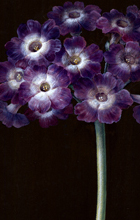Pollination: Function of Flower Forms
In The Different Forms of Flowers on Plants of the Same Species (1877), Darwin delved into the topic of cross-pollination, which provides plant variability. From this variability, nature selects the better adapted. What strategies, he wondered, do plants develop to increase the chances of cross-pollination? |
||
|
|
||
| Darwin studied many plants with dimorphic and trimorphic flowers – that is, flowers on different plants with styles and stamens of two or three different lengths. These differences play a critical role in ensuring cross-pollination – and preventing self-pollination. | ||
 |
 |
 |
| Gouache painting of Auricula primrose by Barbara Dietzsch (c. 1750-1759) | Wood engraving of common primrose by George Mackley (1965) | Ink drawing of a cowslip by Stella Ross-Craig (Drawings of British Plants, vol. 20, pl, 8, 1950). |
|
|
||
 |
||
| In this diagram of a primrose Darwin shows how a dimorphic plant’s construction increases the chances for cross-pollination. A nectar-seeking insect visiting the flower on the right, with a long stamen, exits dusted with pollen. It then flies to the flower on the left, with a long style. Pollen on that insect is perfectly positioned to rub off onto the flower’s stigma. (Figure 2 from Forms of Flowers by Charles Darwin, 1877) | ||
|
|
||
|
|
||
| The European loosestrife (Lythrum salicaria) exemplifies a flower with trimorphic arrangements. In this illustration from Forms of Flowers (1877), Darwin shows the complicated pathways bees must travel to successfully pollinate or, in his words, make a “legitimate union,” in a trimorphic flower. (Darwin’s illustration of trimorphic flowers of Lythrum salicaria in Forms of Flowers, 1877) | ||
|
|
||
 |
Darwin observed that most species of Oxalis (wood-sorrel) seem to be trimorphic – an adaptation for insect pollination. However, some are homostyled with long stamens and long styles. This structural modification permits self-pollination, as a sort of bet-hedging tactic to optimize the chances of reproduction. Perhaps not surprisingly, these are often our common weedy wood-sorrels. | |
|
Hand-colored engraving by Nikolaus J. Jacquin from Oxalis Monographia, 1794. View digitized verion of this work at Botanicus.org |
||
|
|
||
 |
Sweet violet (Viola odorata) is typical of plants producing two types of flowers: small, closed flowers near the ground that are self-fertilized and larger, open flowers exposed for insect pollination. Darwin found 55 genera with these two types of flowers, including most species of wood sorrels and violets. Can you think of environmental factors that might favor such flowers? | |
|
Ink drawing by Stella Ross-Craig from Drawings of British Plants, vol. 4, pl. 7, 1950. |
||
|
|
||
| Next – Pollination: the Mystery of Attraction | ||


